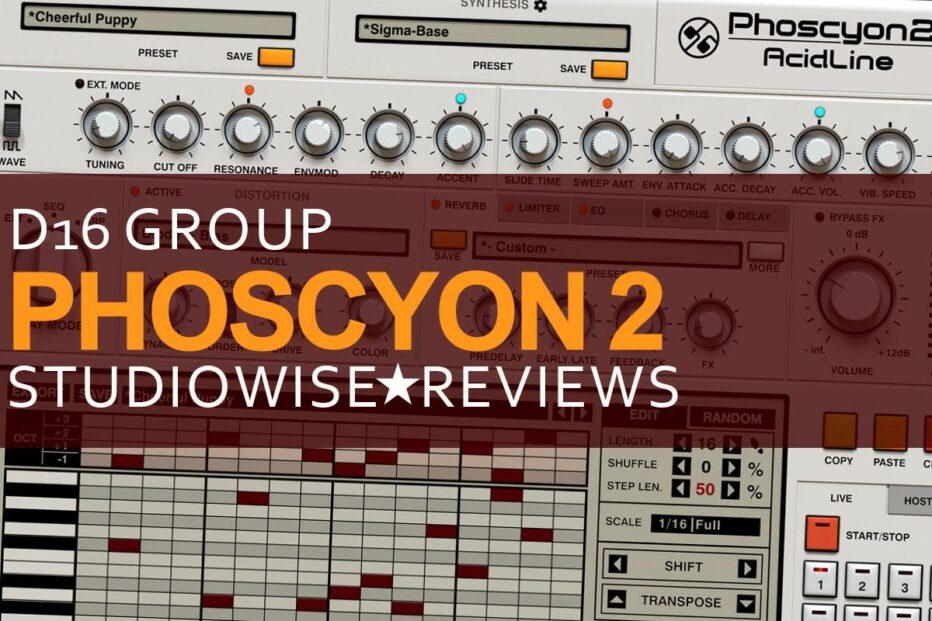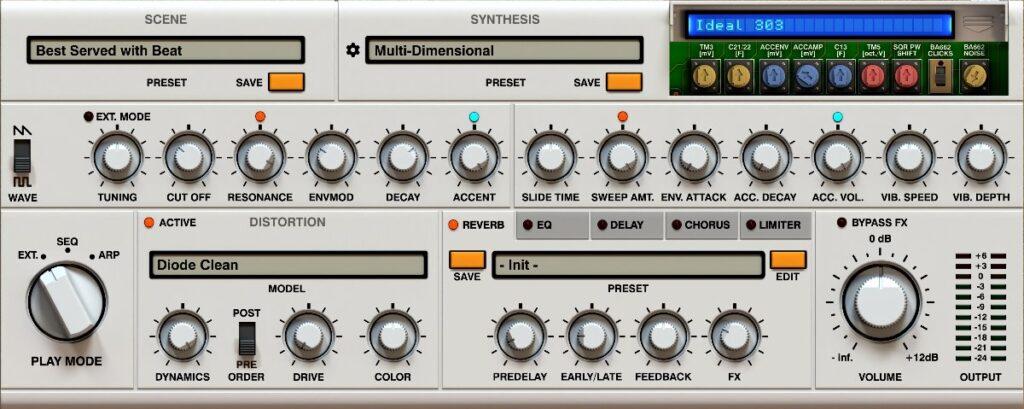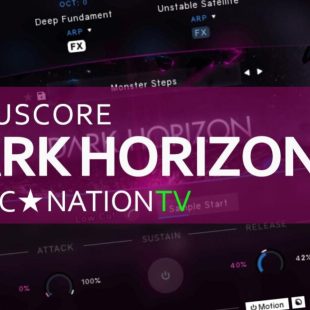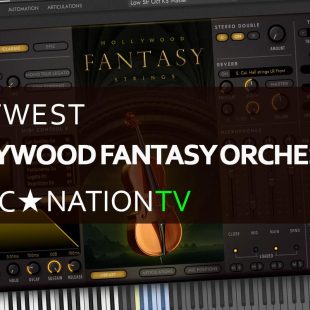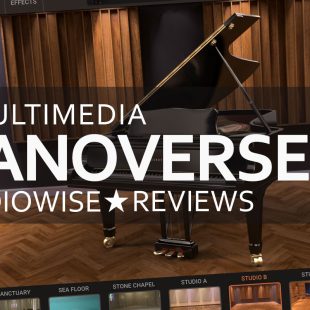D16 Group Phoscyon 2 – Bass Attack
Welcome to Music Nation and our first look at D16 Group’s Phoscyon 2 AcidLine. With a vast number of Roland TB-303 clones on the market these days a developer would need to bring something more to the table than just a faithful recreation of the original hardware. It’s one thing to model every nut and bolt true to the real device, but to create something that doesn’t sound dated in contemporary productions – while keeping the purists happy, is the real challenge.
(Updated May, 2023) I do recall experimenting with the original Roland silver box back in the 80s, but my fond memories for the acid bass genre were with the now-defunct Propellerhead Rebirth RB-338, the original soft synth pioneer. D16 Group offer a complete collection of modules to build your own electro-monster, including the 808, 909 and TB-303. With this new update to Phoscyon, it’s going to be interesting to see what new features they can introduce to help it stand out in an ocean of similar products on the market.
Overview
Though Phoscyon (Foss-See-Yon) may be a mouthful to pronounce, and after two weeks of reviewing the unit I still struggle to remember, it will have a distinctive presence and become a prominent go-to in your projects thanks to its addictive workflow and fantastic skeuomorphic GUI.
The excellent product manual is well worth a quick read-through to familiarize yourself with the device, even if you’re a seasoned 303 veteran, as there are a number of clever yet slightly hidden features worth discovering.
On the first view, the GUI is well-loaded with knobs and buttons, including a huge alternative step sequencer display and an intriguing hidden flap at the top of the unit hiding away secret service tweaks that will surely upset the purists. Happily, it is very easy to run the unit in somewhat factory mode if you’re after the simulation experience.
Getting some sound from the device is a little confusing at first. The large Play Mode dial needs to be set in one of three positions, either “Ext” mode, meaning your DAW or MIDI keyboard controls the device much like a sound module, “Sequence” mode so now the pattern sequencer work when you either press play in your DAW track or hit the orange Start/Stop button in the live section, or finally “Arp” mode, meaning the synth will play a custom combination of notes depending on what chord pattern you’re holding down on your MIDI keyboard. Sequence mode is your typical setting for playing back the preset grooves and the only setting for working with the pattern sequencer, but more on that later.
The device is split into two main sections, the sound control and sequencer with a unique way of handling presets. First, you have the choice of a scene, which is a complete patch including effects and patterns held in memory and the live section. Option two is to load just the synthesis, being the tone only from the sound control section, leaving the current pattern intact. Finally, you can choose from the preset groves from directly within the pattern sequencer. This is a cool way of mixing up presets and saving grooves with each other for those fun happy accidents (or sad accidents if you don’t constantly save your work).

The sound control section is well laid out overall, with the original TB-303 controls on the left and the new mod-inspired knobs on the right. The intent behind Phoscyon 2 is clearly to provide the original foundation features with much of the capabilities to expand on the device. Though this, on the other hand, takes a fairly simplistic device and somewhat over-engineers it to something a lot more complicated under the hood, the core tactile knobs and buttons don’t feel particularly overwhelming once you master the basics and the extra toys are nice.
The Sound
I’m going to be comparing Phoscyon 2 against ReBirth as that is the software I am most familiar with, and luckily still have a bunch of individual stem recordings dating back to some mid-2000s remix tracks so I had some original source material to work with. While, of course, Rebirth wasn’t the perfect clone of the 303 in the first place, it was in some ways pioneering at the time re-energising the genre and launching a million bedroom producers onto the scene and I’m sure like me there a lot of folks more familiar with that than the silver box hardware.
While Phoscyon 2 certainly is capable of sounding like Rebirth, one of the more immediate differences I noticed when adventuring through the presets is the stereo width and clarity. Rebirth had a very pronounced sub-bass range which always required some degree of filtering. Phoscyon has a much more defined pre-effect sound, I dare not say ‘thin’, but clearer. This reacts better when effects are added, particularly the distortion when used aggressively drastically affecting the overall tone of the instrument. But out of the box with no effect, yes Phoscyon 2 lacks a lot of punch and bass.
Of course, this is remedied fairly easily with layers in effect. In fact, even the most heavy-handed application of reverb, delay and chorus didn’t result in mushy garbage. The effects are, on the whole, very well tailored to the synth.
While I couldn’t find anything particularly characterful in the modulation effects, the distortion is outstanding and included multiple well-designed modes to choose from. Each of these modes is very affected by the input signal so there is a vast array of tone potential between sweeping the last 80-90% of the distortion gain when the cut-off is wide open. The saturation just gets thick and creamy no matter the distortion type used. This effect in itself becomes a useful tool in your tone-sculpting arsenal meaning you really need to check multiple distortion modes with full drive to hear how much the filter is going to be affected. Glorious stuff.
Probably the only real gripe is the lack of internal panning for either the synth or the effects, in particular the delay unit. Rebirth was well known for its panned delay lines (since it used two RB-303 units), so it was very easy to dial in the huge panned wall of sound. It’s easy enough to split Phoscyon’s outbound signal and apply a delay from your DAW, but this seems like a huge oversight to me.
The effects in general, a fairly ho-hum. Nothing sounds particularly amazing, but they provide basic splosh in a pinch. To really get things moving you’ll want to modulate external effects, fans of Bitwig Studio will already know exactly what I mean here. Decent reverbs like Eventide Blackhole and pretty much anything-Valhalla just work so well with Phoscyon 2, a real match made in heaven.
Performance
Phoscyon 2 shines as a live performance synth and D16 have injected some rather nifty features for crafting your performance on the fly. With performance being the core word here, as with the hardware, this needs to be manipulated, tweaked, dialled, and affect constantly to bring it alive. Not only are all controls MIDI mappable, but as to are the live overrides which act like DJ kill buttons allowing you to drop elements in and out as you need.
The pattern sequencer is extremely well tailored for performance, with not only a decent set of preset grooves to kick you off but a very intuitive randomisation system that takes you in inspiration directions, not total glitch weirdness as most similar functions I’ve seen. You can define what part of your groove is armed for randomisation, then tap the Draw button to get new patterns applied. The clever part is they don’t get applied 100%, but rely on a dialable amount meaning you can bring in a little or a lot of the new suggested groove. It’s a very immersive system when you’re in full jam mode as random patterns feel much more organic (have a look at our supporting playthrough video below).
While the pattern buttons are great for saving and copying/pasting grooves on the fly, I particularly love the ability to save MIDI patterns by simply dragging and dropping them directly to your DAW. Sometimes I luck upon a tasty groove that doesn’t quite fit my theme, so it’s dead easy to save it down to the DAW for something in the future.
The only fly in the ointment is a lack of undo function. In the heat of the moment, the ability to go back to that groove that was killing it 2-minutes ago would be so handy.
Phoscyon 2 fits like a glove with other related D16 Group instruments, the 909 (Drumazon) and the 808 (Napheton). These two lack the modern graphics of Phoscyon but tonally sit really nicely together as a trio. I hope in future updates D16 might consider adding cross-instrument sync so you could control them all in a group, perhaps some kind of shell application you could play them all from within?
Conclusion
Far from just a one-to-one clone, Phoscyon 2 is really a unique synth in its own right that just happens to have an excellent TB-303 as its heart. While it is possible to manhandle it into simulating the original hardware, or Rebirth if that is your benchmark like me, it has the functions to adventure away from the old 90’s trance days into something more usable in today’s modern productions. This is not to say it can’t faithfully reproduce the original silver box tone fairly well, which it can, it’s just if that’s all you want there are many other far cheaper alternatives out there.
I’m somewhat disappointed with the included effects, particularly the lack of panning on the delay, meaning you’ll still need to lean on your 3rd party alternatives, things like Blackhole or PSP Audioware Springbox for the classic acid house ambience.
The fantastic pattern sequencer is so damn addictive and intuitive in use, it really shines for developing ideas or springboarding new grooves on the fly. I can see this being incredible for live performance, but I would love to see a better sync between other D16 devices and a simple undo button would be amazing.
Excellent sounding and extremely versatile bass synth, Phoscyon 2 should be the default centre of your electro synth set-up, with a fantastic catalogue of related drum machines and effects available from the D16 website, this really is your one-stop electro producers shop.
For full detail head on over to d16 Group’s main website https://d16.pl
Like the review? Shout us a cup of coffee!

